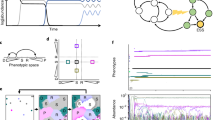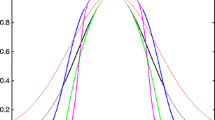Abstract
In this paper we develop a dynamical theory of coevolution in ecological communities. The derivation explicitly accounts for the stochastic components of evolutionary change and is based on ecological processes at the level of the individual. We show that the coevolutionary dynamic can be envisaged as a directed random walk in the community's trait space. A quantitative description of this stochastic process in terms of a master equation is derived. By determining the first jump moment of this process we abstract the dynamic of the mean evolutionary path. To first order the resulting equation coincides with a dynamic that has frequently been assumed in evolutionary game theory. Apart from recovering this canonical equation we systematically establish the underlying assumptions. We provide higher order corrections and show that these can give rise to new, unexpected evolutionary effects including shifting evolutionary isoclines and evolutionary slowing down of mean paths as they approach evolutionary equilibria. Extensions of the derivation to more general ecological settings are discussed. In particular we allow for multi-trait coevolution and analyze coevolution under nonequilibrium population dynamics.
Similar content being viewed by others
References
Abrams, P. A.: Adaptive responses of predators to prey and prey to predators: the failure of the arms-race analogy. Evolution40, 1229–1247 (1986)
Abrams, P. A., Matsuda, H., Harada, Y.: Evolutionarily unstable fitness maxima and stable fitness minima of continuous traits. Evol. Ecol.7, 465–487 (1993)
Bailey, N. T. J.: The elements of stochastic processes. New York: John Wiley and Sons 1964
Baker, G. L., Gollub, J. P.: Chaotic dynamics: an introduction. Cambridge: Cambridge University Press 1990
Brown, J. S., Vincent, T. L.: Coevolution as an evolutionary game. Evolution41, 66–79 (1987a)
Brown, J. S., Vincent, T. L.: Predator-prey coevolution as an evolutionary game. In: Cohen, Y. (ed.) Applications of Control Theory in Ecology, pp. 83–101. Lecture Notes in Biomathematics 73. Berlin: Springer Verlag 1987b
Brown, J. S., Vincent, T. L.: Organization of predator-prey communities as an evolutionary game. Evolution46, 1269–1283 (1992)
Christiansen, F. B.: On conditions for evolutionary stability for a continuously varying character. Amer. Natur.138, 37–50 (1991)
Dawkins, R.: The selfish gene. Oxford: Oxford University Press 1976
Dawkins, R., Krebs, J. R.: Arms races between and within species. Proc. Roy. Soc. Lond. B205, 489–511 (1979)
Dieckmann, U.: Coevolutionary dynamics of stochastic replicator systems. Jülich Germany: Berichte des Forschungszentrums Jülich (Jül-3018) 1994
Dieckmann, U., Marrow, P., Law, R.: Evolutionary cycles in predator-prey interactions: population dynamics and the Red Queen. J. Theor. Biol.176, 91–102 (1995)
Ebeling, W., Feistel, R.: Physik der Selbstorganisation und Evolution. Berlin: Akademie-Verlag 1982
Eckmann, J.-P., Ruelle, D.: Ergodic theory of chaos and strange attractors. Rev. Mod. Phys.57, 617–656 (1985)
Emlen, J. M.: Evolutionary ecology and the optimality assumption. In: Dupre, J. (ed.) The latest on the best, pp. 163–177. Cambridge: MIT Press 1987
Eshel, I.: Evolutionary and continuous stability. J. Theor. Biol.103, 99–111 (1983)
Eshel, I., Motro, U.: Kin selection and strong stability of mutual help. Theor. Pop. Biol.19, 420–433 (1981)
Falconer, R. A.: Introduction to quantitative genetics. 3rd Edition. Harlow: Longman 1989
Fisher, R. A.: The genetical theory of natural selection. New York: Dover Publications 1958
Futuyma, D. J., Slatkin, M.: Introduction. In: Futuyma, D. J., Slatkin, M. (eds.) Coevolution, pp. 1–13. Sanderland Massachusetts: Sinauer Associates 1983
Gillespie, D. T.: A general method for numerically simulating the stochastic time evolution of coupled chemical reactions. J. Comp. Phys.22, 403–434 (1976)
Goel, N. S., Richter-Dyn, N., Stochastic models in biology. New York: Academic Press 1974
Hofbauer, J., Sigmund, K.: Theory of evolution and dynamical systems. New York: Cambridge University Press 1988
Hofbauer, J., Sigmund, K.: Adaptive dynamics and evolutionary stability. Appl. Math. Lett.3, 75–79 (1990)
Iwasa, Y., Pomiankowski, A., Nee, S.: The evolution of costly mate preferences. II. The “handicap” principle. Evolution45, 1431–1442 (1991)
Kimura, M.: The neutral theory of molecular evolution. Cambridge: Cambridge University Press 1983
Kubo, R., Matsuo, K., Kitahara, K.: Fluctuation and relaxation of macrovariables. J. Stat. Phys.9, 51–96 (1973)
Lande, R.: Quantitative genetic analysis of multivariate evolution, applied to brain: body size allometry. Evolution33, 402–416 (1979)
Lawlor, L. R., Maynard Smith, J.: The coevolution and stability of competing species. Amer. Natur.110, 79–99 (1976)
Lewontin, R. C.: Pitness, survival, and optimality. In: Horn, D. J., Stairs, G. R., Mitchell, R. D. (eds.) Analysis of Ecological Systems, pp. 3–21. Ohio State University Press 1979
Lewontin, R. C.: Gene, organism and environment. In: Bendall, D. S. (ed.) Evolution from molecules to men, pp. 273–285. Cambridge: Cambridge University Press 1983
Lewontin, R. C.: The shape of optimality. In: Dupre, J. (ed.) The latest on the best, pp. 151–159. Cambridge: MIT Press 1987
Loeschke, V. (ed.): Genetic constraints on adaptive evolution. Berlin: Springer-Verlag 1987
Mackay, T. F. C.: Distribution of effects of new mutations affecting quantitative traits. In: Hill, W. G., Thompson, R., Woolliams, J. A. (eds.) Proc. 4th world congress on genetics applied to livestock production, pp. 219–228. 1990
Marrow, P., Cannings, C.: Evolutionary instability in predator-prey systems. J. Theor. Biol.160, 135–150 (1993)
Marrow, P., Dieckmann, U., Law, R.: Evolutionary dynamics of predator-prey systems: an ecological perspective. J. Math. Biol.34, 556–578 (1996)
Marrow, P., Law, R., Cannings, C.: The coevolution of predator-prey interactions: ESSs and Red Queen dynamics. Proc. Roy. Soc. Lond. B250, 133–141 (1992)
Maynard Smith, J.: Evolution and the theory of games. Cambridge: Cambridge University Press 1982
Maynard Smith, J., Burian, R., Kauffman, S. Alberch, P., Campbell, J., Goodwin, B., Lande, R., Raup, D., Wolpert, L.: Developmental constraints and evolution. Q. Rev. Biol.60, 265–287 (1985)
Maynard Smith, J., Price, G. R.: The logic of animal conflict. Nature Lond.246, 15–18 (1973)
Metz, J. A. J., Nisbet, R. M., Geritz, S. A. H.: How should we define “fitness” for general ecological scenarios? Trends Ecol. Evol.7, 198–202 (1992)
Metz, J. A. J, Geritz, S. A. H., Iwasa, Y.: On the dynamical classification of evolutionarily singular strategies. University of Leiden Preprint (1994)
Nicolis, J. S.: Dynamics of hierarchical systems. Berlin: Springer-Verlag 1986
Ott, E.: Chaos in dynamical systems. Cambridge: Cambridge University Press 1993
Rand, D. A., Wilson, H. B.: Evolutionary catastrophes, punctuated equilibria and gradualism in ecosystem evolution. Proc. Roy. Soc. Lond. B253, 239–244 (1993)
Rand, D. A., Wilson, H. B., McGlade, J. M.: Dynamics and evolution: evolutionarily stable attractors, invasion exponents and phenotype dynamics. Phil. Trans. Roy. Soc. Lond. B343, 261–283 (1994)
Reed, J., Stenseth, N. C.: On evolutionarily stable strategies. J. Theor. Biol.108, 491–508 (1984)
Rosenzweig, M. L., Brown, J. S., Vincent, T. L.: Red Queens and ESS: the coevolution of evolutionary rates. Evol. Ecol.1, 59–94 (1987)
Roughgarden, J.: The theory of coevolution. In: Futuyma, D. J., Slatkin, M. (eds.) Coevolution, pp. 33–64. Sunderland Massachusetts: Sinauer Associates 1983.
Saloniemi, I.: A coevolutionary predator-prey model with quantitative characters. Amer. Natur.141, 880–896 (1993)
Schuster, H. G.: Deterministic chaos: an introduction. Weinheim: VCH Verlagsgesellschaft 1989
Serra, R., Andretta, M., Compiani, M., Zanarini, G.: Introduction to the physics of complex systems. Oxford: Pergamon Press 1986
Stearns, S. C.: The evolution of life histories. Oxford: Oxford University Press 1992
Takada, T., Kigami, J.: The dynamical attainability of ESS in evolutionary games. J. Math. Biol.29, 513–529 (1991)
Taper, M. L., Case, T. J.: Models of character displacement and the theoretical robustness of taxon cycles. Evolution46, 317–333 (1992)
Taylor, P. D.: Evolutionary stability in one-parameter models under weak selection. Theor. Pop. Biol.36, 125–143 (1989)
van Kampen, N. G.: Fundamental problems in statistical mechanics of irreversible processes. In: Cohen, E. G. D. (ed.) Fundamental problems in statistical mechanics, pp. 173–202. Amsterdam: North Holland 1962
van Kampen, N. G.: Stochastic processes in physics and chemistry. Amsterdam: North Holland 1981
Vincent, T. L.: Strategy dynamics and the ESS. In: Vincent, T. L., Mees, A. I., Jennings, L. S. (eds.) Dynamics of complex interconnected biological systems, pp. 236–262. Basel: Birkhäuser 1990
Vincent, T. L., Cohen, Y., Brown, J. S.: Evolution via strategy dynamics. Theor. Pop. Biol.44, 149–176 (1993)
Wissel, C., Stöcker, S.: Extinction of populations by random influences. Theor. Pop. Biol.39, 315–328 (1991)
Author information
Authors and Affiliations
Rights and permissions
About this article
Cite this article
Dieckmann, U., Law, R. The dynamical theory of coevolution: a derivation from stochastic ecological processes. J. Math. Biology 34, 579–612 (1996). https://doi.org/10.1007/BF02409751
Received:
Revised:
Issue Date:
DOI: https://doi.org/10.1007/BF02409751




